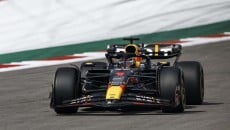We’re writing about nothing for the moment, because nothing has been made official yet, but the press conference on Saturday morning with Ezpeleta, Viegas, and Poncharal will anticipate the news: the famous, or infamous "Sprint Race" that first saw the light in the Superbike and was then also adopted in the F1 (but not in all the Grand Prixs).
The SBK has always brought innovation to motorcycling: Maurizio Flammini was the first to marry the single tire, thanks to Pirelli, then there was the Superpole format, with Race 1 and Race 2. In short, the SBK has progressed before and has always been ahead of everyone else.
On the Friday of the Austrian Grand Prix, the reactions were mixed, especially those of the riders: they knew nothing about it. They heard it on the news, and this put them in a bit of an off mood. So what’s the point of having a Safety Commission if such an important change to the race weekend is not communicated to the riders?
Our impression is that – if they go through with it – Dorna and the FIM (IRTA counts little or nothing now, but neither does the FIM) wanted to avoid this confrontation and present it as a done deal.
We should point out that the Superbike has taken the news rather well, after the initial surprise, but Fabio Quartararo's cutting comment: “Twenty-one races are already too many. It becomes too dangerous. It’s stupid,” finds a first justification in the difference between the two calendars: 13 races against 21 Grand Prixs.
It’s true: the World Championship would go from 21 races to 42, but the SBK, which already has Race 1, the Superpole Race, and then Race 2 on Sunday, is at 39... with one difference: there’s much more time between the Superbike tests. The calendar provides for long breaks, so there’s more chance of recuperating in the unfortunate case of accidents. This was something the world champion emphasized.
Of course, if they do add the Sprint Race, the weekend will end up being organized differently: the FP4 – the free practice that teams and riders use to adjust the bike for the race pace – will probably be cancelled.
But there’s more. Currently, the qualifying system involving the FP3 that rewards the top 10 with direct access into the Q2, reserving only two spots in the Q1, could also change, seeing that, in the Superbike, the first 9 of the Superpole Race win the first three rows of the line-up, devaluing the Q2.
It is, however, true that they have to qualify for the Superpole Race, or Sprint Race, if you prefer. In a short race, in fact, starting ahead is even more important! But the MotoGP could follow a different path, further complicating understanding the regulations between the two categories.
This will definitely involve a massive renewal of the system with which the teams prepare for the Grand Prix, because they’ll have less time to improve the set-up and choose the tires. There will be more pressure, not only on the rider, but on the entire team.
Last but not least, there’s the fatigue factor: talking to the riders, not today, but for some time now, those who have tried both bikes, Superbike and MotoGP, agree that the latter, being more rigid and better in braking, as well as more powerful, is much more tiring to take to the limit. On the contrary, with the “gentler” SBK, the riders manage to reach the bike’s limit before reaching their physical limit.
So, looking at the pros and cons, why did Dorna decide to take the risks we just outlined? Simple … because, like KTM’s manager Francesco Guidotti rightly said “Surely, there’s a greater risk than a normal qualification. But it arouses interest and shifts the interest of some spectators to Saturdays. I’m not entirely against it, but it obviously needs to be structured well.”
More than anything else, the financial aspect of the issue comes to mind. There’s undoubtedly a drop in attention in the MotoGP due to a number of factors: financial, but also the lack of protagonists, including two big shots like Rossi and Marquez. The result is that Dorna's biggest funders, TVs, are definitely trying to renegotiate and down-cut their contracts. And that’s why they’re now offering more. More races, more entertainment, in exchange for the same financial support, without down-cutting.
A bit like when newspapers, faced with less copies sold, began to be sold as a “sandwich”, namely, offering an extra newspaper at the same newsstand price. It was an experiment that didn’t go too well.
The reality is that everything changes, and the MotoGP is also part of these absurd times. But it’s a pity Dorna hasn’t yet realized that, once again, they should follow the first example given by Flammini in the Superbike: opening more to the public that, in the SBK paddock, like they do in America, has access to riders and motorcycles. The lack of protagonists isn’t taken into account, growth isn’t favored, and they hold the monopoly!










